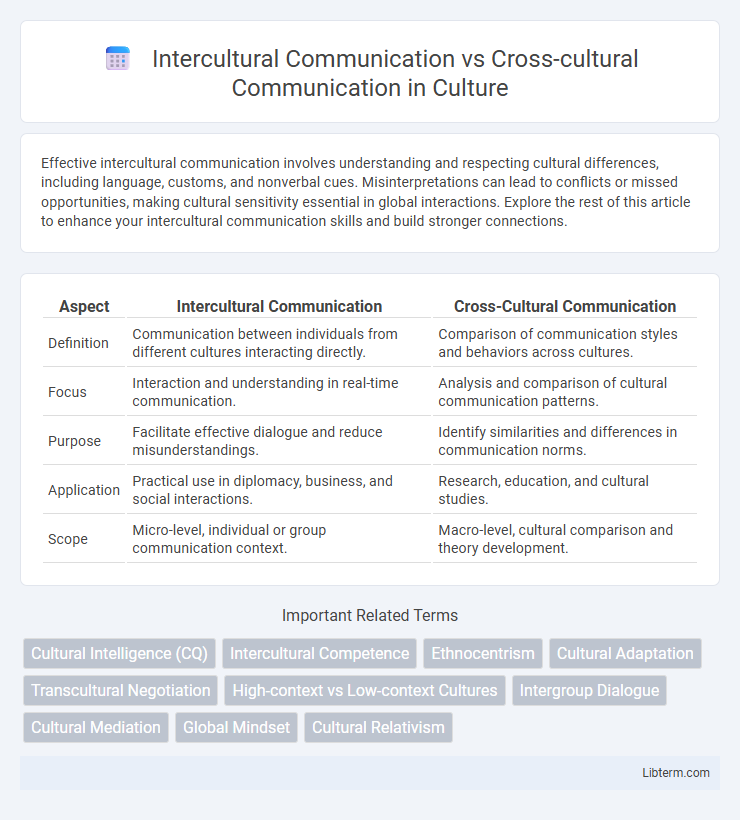Effective intercultural communication involves understanding and respecting cultural differences, including language, customs, and nonverbal cues. Misinterpretations can lead to conflicts or missed opportunities, making cultural sensitivity essential in global interactions. Explore the rest of this article to enhance your intercultural communication skills and build stronger connections.
Table of Comparison
| Aspect | Intercultural Communication | Cross-Cultural Communication |
|---|---|---|
| Definition | Communication between individuals from different cultures interacting directly. | Comparison of communication styles and behaviors across cultures. |
| Focus | Interaction and understanding in real-time communication. | Analysis and comparison of cultural communication patterns. |
| Purpose | Facilitate effective dialogue and reduce misunderstandings. | Identify similarities and differences in communication norms. |
| Application | Practical use in diplomacy, business, and social interactions. | Research, education, and cultural studies. |
| Scope | Micro-level, individual or group communication context. | Macro-level, cultural comparison and theory development. |
Defining Intercultural Communication
Intercultural communication refers to the interaction between people from different cultural backgrounds aiming to exchange information, ideas, and values effectively. It emphasizes understanding and managing cultural differences to reduce misunderstandings and enhance cooperation. This process involves verbal and nonverbal communication, cultural awareness, and sensitivity to diverse social norms and practices.
Understanding Cross-cultural Communication
Cross-cultural communication focuses on comparing communication styles between distinct cultures to identify differences and similarities, facilitating effective interaction in diverse settings. Understanding cross-cultural communication requires recognizing cultural norms, language nuances, and non-verbal cues unique to each culture, which reduces misunderstandings and enhances collaboration. Mastery of cross-cultural communication empowers individuals and organizations to navigate global environments with sensitivity and competence, promoting mutual respect and successful outcomes.
Key Differences Between Intercultural and Cross-cultural Communication
Intercultural communication involves direct interaction between individuals from different cultural backgrounds, emphasizing real-time understanding and adaptation during communication. Cross-cultural communication centers on comparing communication styles, behaviors, and norms across cultures, often through research or analysis without immediate interaction. Key differences include intercultural communication's focus on dynamic, situational exchanges, whereas cross-cultural communication highlights systematic comparison and knowledge of cultural variations.
Importance in Globalized Environments
Intercultural communication enhances understanding by facilitating effective interaction between individuals from diverse cultural backgrounds, which is crucial for global business success and international collaboration. Cross-cultural communication compares and contrasts cultural norms and values to identify differences and similarities, helping organizations adapt strategies to various markets. Both approaches improve conflict resolution and teamwork in multinational environments, driving innovation and fostering inclusive workplaces.
Theoretical Frameworks and Models
Intercultural communication theories like Hofstede's Cultural Dimensions and Hall's High-Context vs Low-Context framework explore how individuals from different cultural backgrounds interact and understand each other within a shared context. Cross-cultural communication models, such as Edward T. Hall's Time Orientation and Trompenaars' Seven Dimensions of Culture, focus on comparing communication patterns and cultural norms across distinct cultures to identify differences and similarities. Both frameworks emphasize the importance of cultural awareness and adaptability but diverge in scope, with intercultural models centered on interaction dynamics and cross-cultural models on comparative analysis.
Barriers and Challenges
Intercultural communication faces barriers such as language differences, nonverbal misunderstandings, and ethnocentrism, which hinder effective interactions between individuals from different cultures. Cross-cultural communication challenges include contrasting social norms, values, and communication styles that can lead to stereotypes, misinterpretations, and conflicts. Both fields require cultural awareness, empathy, and adaptive communication strategies to overcome these obstacles and foster mutual understanding.
Role in International Business
Intercultural communication focuses on interactions within culturally diverse settings, emphasizing understanding cultural differences to enhance collaboration and reduce conflicts in international business. Cross-cultural communication compares and contrasts communication styles across cultures, helping businesses tailor strategies for effective negotiation, marketing, and management. Both approaches are essential for building trust, fostering partnerships, and achieving competitive advantage in the global marketplace.
Effective Strategies for Communication
Intercultural communication emphasizes understanding and adapting to cultural differences within interactions, focusing on empathy and active listening to bridge gaps. Cross-cultural communication compares and contrasts communication styles across cultures, promoting strategies like cultural awareness training and contextual sensitivity to avoid misunderstandings. Effective strategies include using clear, simple language, recognizing nonverbal cues, and fostering open dialogue that respects cultural norms and values.
Case Studies and Real-world Examples
Intercultural communication emphasizes dynamic interactions and adaptability within diverse cultural contexts, illustrated by case studies such as multinational teams navigating workplace misunderstandings in global corporations like IBM. Cross-cultural communication involves comparative analyses of cultural norms and practices, exemplified by research on negotiation styles between American and Japanese business professionals. Real-world examples highlight that intercultural communication fosters ongoing dialogue and cultural sensitivity, while cross-cultural communication provides frameworks for understanding cultural differences to prevent conflicts.
Future Trends and Developments
Intercultural communication is evolving with advancements in AI and virtual reality, enhancing real-time language translation and immersive cultural experiences that foster deeper understanding. Cross-cultural communication is increasingly data-driven, utilizing big data analytics to identify and bridge cultural gaps in global business and diplomacy. Future developments prioritize integrating technology with cultural intelligence training to support seamless collaboration across diverse cultural contexts.
Intercultural Communication Infographic

 libterm.com
libterm.com